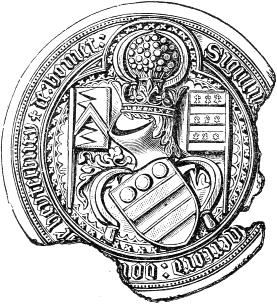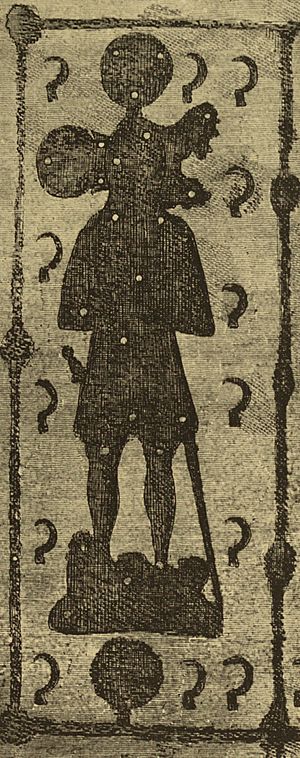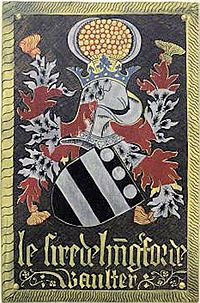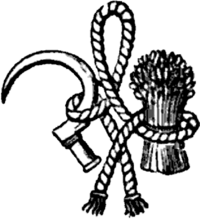Walter Hungerford, 1st Baron Hungerford facts for kids

Walter Hungerford, 1st Baron Hungerford (born 1378 – died 1449), was an important English knight and landowner. He was a Member of Parliament (MP) for many years, even becoming the Speaker of the House of Commons. Later, he became an Admiral and a noble, known as a Baron.
He was famous for fighting in the Hundred Years' War, including the Battle of Agincourt in 1415. He also represented England at a big meeting called the Council of Constance. In 1417, he became the Admiral of the Fleet, in charge of the navy. When King Henry V died, Walter helped manage the king's will and was part of a special group that helped Duke Humphrey of Gloucester rule. He attended a major conference in Arras in 1435. From 1436 until his death, he was a member of the House of Lords. He also served as the Lord High Treasurer, managing England's money, from 1426 to 1432. This was a time of economic challenges in England.
Contents
Family Background
Walter Hungerford was the only son of Sir Thomas Hungerford, who died in 1398. His father was the first person officially recorded as the Speaker of the House of Commons. Walter's mother was Joan Hussey, who passed away in 1412. She was the daughter of Sir Edmund Hussey.
Life and Achievements
Walter's father strongly supported the Lancastrian family during the time of King Richard II. When King Henry IV became king in 1399, Walter was made a knight. He also started receiving money each year from the lands of Margaret, Duchess of Norfolk.
He served as a Member of Parliament (MP) for Wiltshire several times, and also for Somerset. From January 1413 to 1414, he was the Speaker of the House of Commons, which meant he led the meetings of the MPs.
Walter was also appointed as a local official called Sheriff for Wiltshire in 1405 and for Somerset and Dorset in 1414.
He was known as a brave warrior. In 1401, he was with the English army in France. It is said that he even defeated the French king in a duel outside Calais. He was very good in battles and tournaments, and he received many rewards for his service. In 1403, he was given money every year from the town of Marlborough.
In 1414, he was chosen as an ambassador to make a deal with Sigismund, the King of the Romans. He also represented England at the Council of Constance in 1414–1415.
In 1415, Walter Hungerford went with King Henry V to France with his soldiers. Before the famous Battle of Agincourt, he supposedly wished that the English had more archers, which led to a famous reply from the king. He fought bravely in the battle. After the battle, he was involved in talks with French envoys in 1417.
In 1417, he became the Admiral of the Fleet, serving under John of Lancaster, Duke of Bedford. In 1418, he was with King Henry V during the Siege of Rouen. He was also made the Steward of the King's Household, managing the royal home. He became a Knight of the Garter in 1421, which is a very special honor.
Walter Hungerford was one of the people King Henry V chose to manage his will after he died. In 1422, he joined the council of Humphrey, Duke of Gloucester, who was ruling for the young King Henry VI. In 1424, Walter became the Steward of the Household for the young King Henry VI. In 1426, he was officially called to Parliament as Baron Hungerford, becoming a noble.
He became the Treasurer of England in 1426, managing the country's money. He helped serve King Henry VI at his coronation in Paris in 1430. However, he stopped being Treasurer in 1432. He also attended a big meeting in Arras in 1435.
Family and Marriages
Walter Hungerford was married two times:
- First, he married Catherine (or Eleanor) Peverell. She was the daughter of Sir Thomas Peverell. Walter and Catherine had three sons and at least one daughter:
- Walter Hungerford, their oldest son, was captured in France in 1425. His father paid a large sum of money to free him. He died before his father and did not have any children.
- Robert Hungerford, who became the 2nd Baron Hungerford after his father.
- Edmund Hungerford, who was knighted by King Henry VI. He married Margaret Burnell and had two sons:
- Thomas Hungerford, whose family lived in places like Down Ampney and Windrush.
- Edward Hungerford, whose family lived in Cadenham.
- Elizabeth Hungerford (died 1476), who married Sir Philip Courtenay. When she married, she brought the Molland manor to her husband. She gave it to her second son, Sir Philip Courtenay of Molland, who started a new branch of the Courtenay family there. A piece of an old tomb in Molland Church shows symbols of the Hungerford sickles and a Courtenay dolphin. Her third son was Peter Courtenay, who became a Bishop. His beautiful fireplace in Exeter has many family symbols, including Hungerford sickles and Peverell garbs.
- Second, he married Eleanor Berkeley. She was the daughter of Sir John Berkeley. Eleanor had been married twice before. Walter Hungerford and Eleanor Berkeley did not have any children together.
Death and Burial
Walter Hungerford passed away on August 9, 1449. He was buried next to his first wife in Salisbury Cathedral. There used to be two beautiful chapels built by the Hungerford family in the cathedral, but they were removed in 1790.
A writer named William Hamilton Rogers described the monument in 1877. He said Walter and his wife were buried in the Hungerford Chapel. Their tombs, which were joined together, had lost their metal figures. The stones showed the shapes of a knight and a lady, and were covered with sickles. Many family coats of arms were displayed around the outside of the chapels, showing the families they were connected to.
Good Deeds
Walter Hungerford greatly increased his family's land and wealth through his marriages and gifts from the king. He built special chapels for prayers in Heytesbury and Chippenham. He also left money to Salisbury Cathedral and Bath Cathedral. In 1428, he gave valuable lands to the Royal Chapel in the Palace of Westminster.
In 1442, he started an almshouse in Heytesbury for twelve poor men and one woman, which also had a schoolmaster's home. This charity, called the Hospital of St John, still exists today.
In his will, he left his "best legend of the Lives of the Saints" to his daughter-in-law, Margaret de Botreaux. He also gave a cup that used to belong to John of Gaunt to John, Viscount Beaumont.
In 1407, Hungerford gave the right to choose the priest for the church at his manor of Rushall to the canons of Longleat Priory, who were having financial difficulties.
Images for kids






